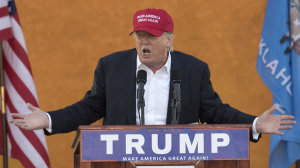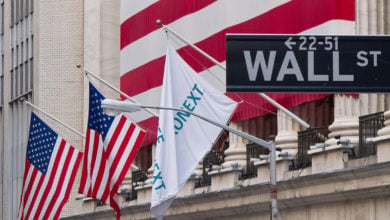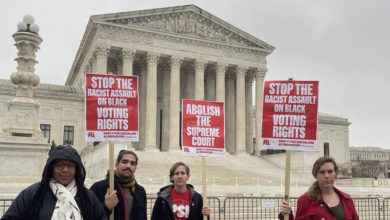 Last week’s Indiana primary has consolidated Donald Trump’s position as the presumptive nominee for the Republican Party in this year’s presidential race. With only Trump left standing, following the suspension of Ted Cruz and John Kasich’s campaigns, some in the GOP establishment are still considering alternatives, while others are coming to terms with the new reality.
Last week’s Indiana primary has consolidated Donald Trump’s position as the presumptive nominee for the Republican Party in this year’s presidential race. With only Trump left standing, following the suspension of Ted Cruz and John Kasich’s campaigns, some in the GOP establishment are still considering alternatives, while others are coming to terms with the new reality.
House Speaker Paul Ryan — the most powerful office-holding Republican politician — has had to publicly swear off aspirations to enter the presidential primary. Many Republican lawmakers, including Ryan, have criticized Trump as a bully, demagogue, fear-mongerer and more. Almost no Republican leaders have enthusiastically stood with Trump, with support ranging between lukewarm endorsements to dry statements that Republicans should stand behind their party’s nominee “regardless if it is Trump or not.”
Of course, none of them admit the reality that Republican policy, rhetoric and strategy over the last years made Trump’s success possible. On the one hand, they cultivated vicious anti-immigrant sentiment and mobilized their base on the basis of white supremacy — with only a little more subtlety than Trump. At the same time they pushed for unlimited money in political campaigns, embraced neoliberal trade agreements, targeted Social Security, and insisted on a disastrous ultra-aggressive foreign policy. They adopted a strategy of obstruction in Congress that led that body to receive the lowest popular approval ratings in history. They created the political climate, inside and outside the Republican Party, that allowed Trump’s message to take off.
Fortifying the domination of the billionaire class
In the Democratic Party, mainstream left-populist politicians such as Elizabeth Warren and Bernie Sanders criticized the infamous Citizens United v. FEC Supreme Court decision and the broader role of “money in politics.” But no national representative of the Republican Party has publicly attacked the decision that allowed unlimited corporate giving to political campaigns.
Mitt Romney said, “I’m not going to criticize the Supreme Court, I’m going to criticize Congress for passing a law that limits what campaigns can receive and opens the door to these super PACs and to PACs which have now been around for a while.” The billionaire investor-capitalist unsurprisingly supports the underlying concept of “corporate personhood,” and the notion that unlimited donations are part of a corporation’s right to “free speech.”
Donald Trump has essentially self-financed his campaign, spending over $36 million so far — about 75 percent of the total revenue for the campaign. This has allowed him to strike an independent pose compared to the Republican establishment that is completely beholden to their corporate funders. But the truth is that Trump has been on the other side of those corporate donations for years. Rather than challenging the domination of the billionaire class, Trump is its ultimate confirmation. He has essentially bought his way onto the center stage.
Racism: A longstanding pillar of GOP strategy
Since the 1960s the Republican Party has relied on racism as a core element of its political strategy and platform — although they have usually not been as explicit as Trump has been with his calls to build a wall to restrict immigration from Latin America and introduce an anti-Muslim test in the immigration process.
As the Democratic Party gradually associated itself with, and sought to capture the political energy of, the insurgent civil rights movement, the Republican Party exploited bigotry among a significant section of Southern whites, notably with Richard Nixon’s “Turn to the South” in the 1968 presidential election. In so doing, the Republican Party became the vehicle for coded racism, especially anti-Black bigotry.
Ronald Reagan drew on this political development by associating himself with the Confederacy and the racist vigilantes who opposed the civil rights movement by murdering movement activists. Shortly after securing the Republican nomination in 1980, Reagan traveled to Neshoba County in Mississippi to deliver a speech in support of “state’s rights” — a nod to the region that had used this phony legal rationale to justify slavery and defend Jim Crow segregation. The venue itself was significant. The nearest town was Philadelphia, Mississippi, the site of the infamous Freedom Summer murders in 1964 where civil rights activists James Chaney, Andrew Goodman and Michael Schwerner were murdered by the KKK. There was no doubt that Reagan’s coded message to Southern white bigots was heard and understood.
Donald Trump clearly has relied on racism to build a right-wing populist movement of those who believe that immigration is the cause of joblessness, that Black America is responsible for its own oppression and that America can be made “great again” through domination over Latin America, the Middle East, and really the whole world.
The slogan “Make America Great Again,” like Reagan’s Mississippi speech, is itself a coded message to return to the “good old days” before the civil rights movement, the gains of immigrants, women and the LGBTQ movement.
Economic collapse and the white working class

Since the 1970s, the American capitalists have gradually moved their manufacturing operations overseas in pursuit of cheaper labor and resource costs, resulting in the deindustrialization of the U.S. economy.
Previously, the imperialist economic pattern was to bring in cheap resources from the colonial periphery to an industrialized center where the finished commodities would be manufactured. A crisis of profitability in the 1970s, however, led the capitalists to opt for a different strategies.
By closing down factories, mills and other centers of manufacturing in the United States and moving those operations overseas, owners of those companies not only found cheaper labor thanks to underdeveloped economies’ low labor prices, but also stood to break up the unions at their existing shops.
The Republican Party functioned as the political arm of wealthy manufacturers, CEOs and financial investors who sought to gain from the process. Factories closures, massive layoffs and the complete devastation of entire cities, especially in the Rust Belt, ruined the lives of tens of millions of workers but the Republican establishment did not miss a beat. They instead shifted the blame on foreign governments, immigration and individual workers’ laziness. “Disciplining” the working class, and making it “leaner” for the sake of global competitiveness, became national slogans.
The Democratic Party threw the labor unions under the bus and accepted the new status quo being pushed by the corporate world.
As a consequence, huge swaths of the working class lost steady employment as good-paying jobs vanished in the restructuring. The industrial working class — previously the mainstay of the U.S. economy — was rendered a niche sub-section, disenchanting millions of workers with the political process altogether.
Donald Trump’s provincialism exploits this disenchantment and anger by explicitly blaming “free trade” deals made by Republican and Democratic lawmakers alike. His call to build a wall on the Mexican border has the same appeal. Trump’s obsession with China appeals to white workers by blaming job loss and poverty on the sale of formerly American jobs to China.
Trump, in other words, cleverly flipped the script, criticizing the actions of the capitalists before him by promising to bring jobs back to the United States.
Endless war and the erosion of the political establishment
In the common vernacular, the Republican Party’s foreign policy is synonymous with aggression, foreign intervention, tough posturing and militarism. That reputation is well-earned. Ronald Reagans’ ultra-aggressive, anti-communist foreign policy became a hallmark of his administration. George W. Bush initiated two major wars, which siphoned billions of tax dollars into military contractors’ pockets and took millions of lives. To this day, Republican leaders John McCain and Lindsay Graham spend most of the year running around the globe to find new wars to start.
This aggressive war-making has failed to stabilize and guarantee global U.S. domination. In fact, it has created greater instability and decreased people’s feelings of security and stability. Media and politicians alike must now wrestle with a population it deems “war weary”—really an expression of public’s knowledge that it has not benefited from the invasion of Iraq, Afghanistan, Libya or other countries devastated in the constant invasions and military interventions.
Trump is opportunistically tapping into that sentiment — in contrast with the Republican establishment and Hillary Clinton, who share the same interventionist vision.
Trump: Bully or gruesome self-reflection?
Trump has generated a large movement around a profoundly bigoted and retrograde platform and generated uncommon excitement in the Republican primary. But the Republican establishment is not happy. Some are still trying to escape a Trump nomination. Why? Trump’s movement gives them an opportunity to capture a significant section of the white working-class and middle-class voters.
It is not really because he is a “bully,” which is their current excuse, nor is it his bigotry. The Republican Party has embodied these very causes, domestically and internationally, for years. They are concerned because, in his antics and showmanship, Trump is pulling the mask off of the Republican Party itself. Throwing stately and polite language to the wind, he is confirming to millions of women, LGBTQ people and people of color what they already think about the Republican Party. Internationally, he can only bring ridicule to a U.S. Empire already in crisis.
Trump is the monster the Republican Party created, and now, hypocritically, they don’t want to see its face.






